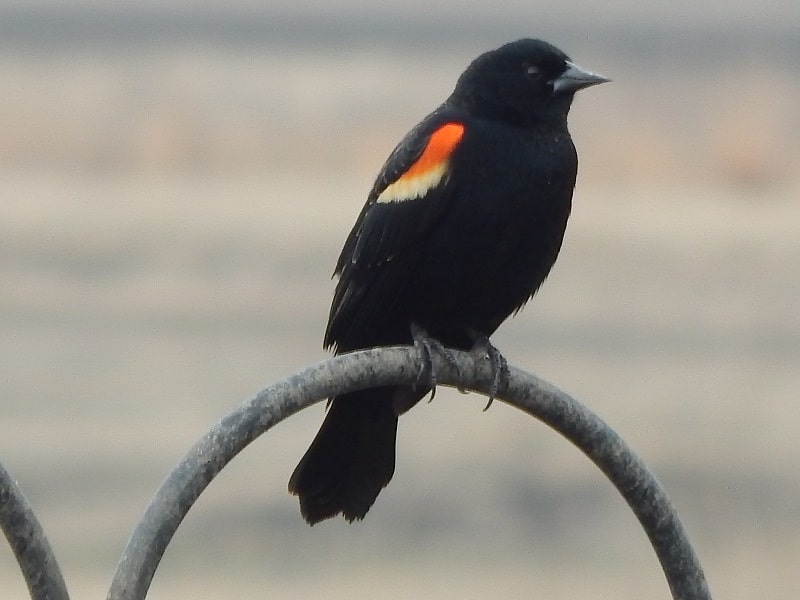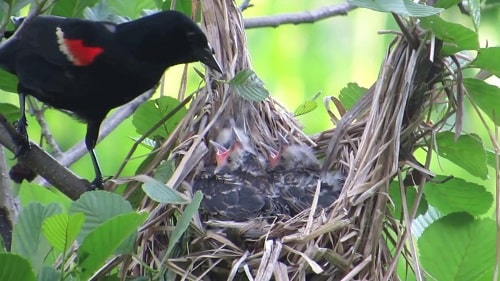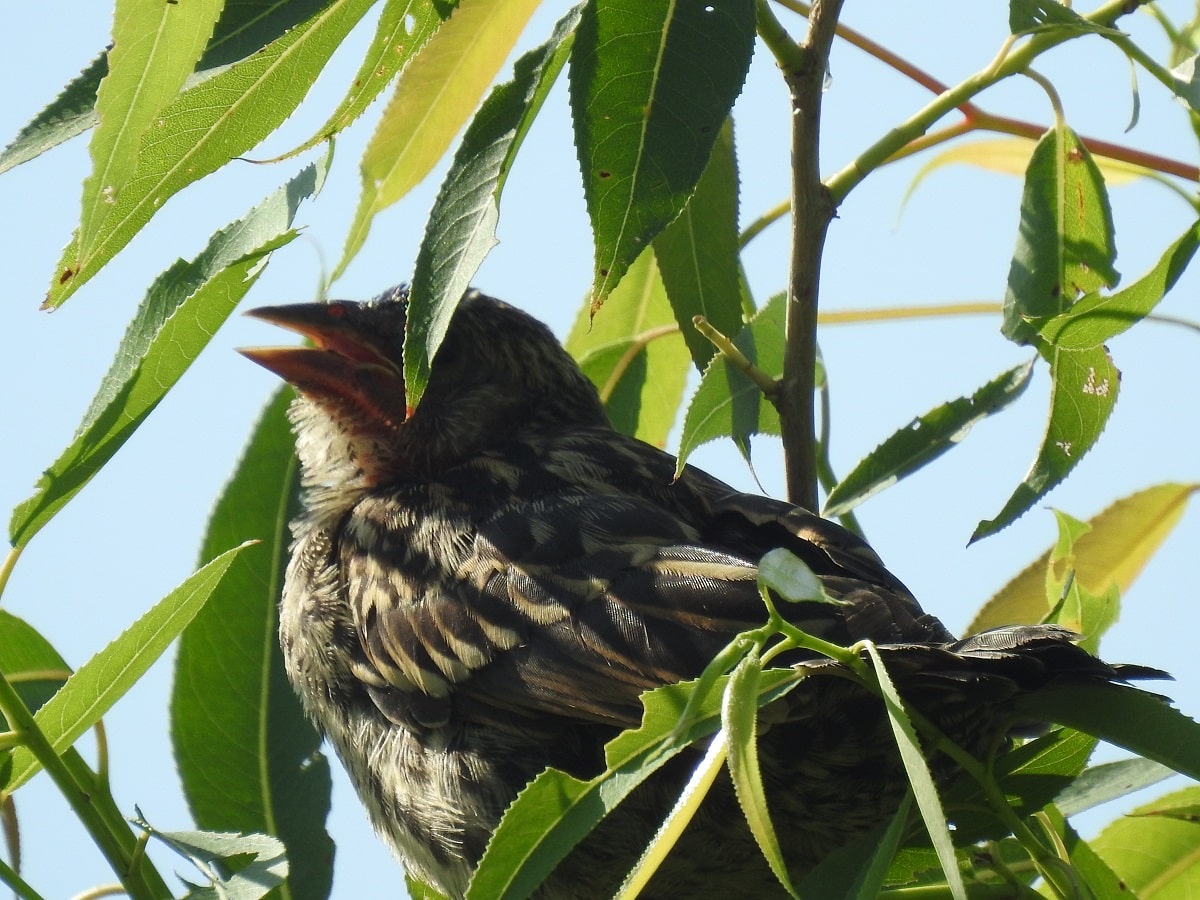Red-winged Blackbird Mating, Nesting, Feeding Habits
Reviewed: September 19, 2025
Typical nesting habitats include wetland marshes and sedge meadows, but also in agricultural fields and grasslands.
In central California, this bird has no yellow on the shoulder patch. They are sometimes called Bicolored Blackbirds.

Appearance: Size, Field Marks
The Red-wing Blackbird is 7 to 9.5 inches in length. Males are unmistakable with their glossy black plumage and vibrant red shoulder patches, bordered by yellow in most regions.
In central California, this patch lacks the yellow border, giving these birds the nickname "Bicolored Blackbirds."
These patches, also called epaulets, are especially prominent when the male is singing or displaying.
Females look completely different. They are brown above, heavily streaked brown below, with a sharp, pointed bill and a buff-colored eyebrow.
Young males resemble adult females but are darker and have an orangish shoulder patch bordered by white.
Young females look just like adult females.
Red-winged Blackbird Call
Mating Rituals - Courtship Habits
Wintering in the southern states, the birds head north at the first hint of spring.
The males arrive first, with the females arriving several weeks later.
Older males arrive first, staking their territory and defending it against other males. You may see them in early spring at your feeders.
These nesting territories range in size from 1/8 to 1/4 of an acre. Males show dominance of an area by singing from perches and displaying theirred shoulder patches.
During the breeding season, males establish territories and perform elaborate courtship displays to attract females.
These displays involve the male puffing up his feathers, spreading his wings, and flashing his bright red shoulder patches while singing a distinctive song.
Do Red-winged Blackbirds Mate for Life?
Red-winged Blackbirds are polygynous, meaning they mate with multiple females. Red-winged Blackbirds do not mate for life with any of them.
The size of a male's territory can determine how many females he can attract and mate with. Three mates per breeding season are the average.
Females select which territory to nest in and breed with the male of that territory.
The pair ends their relationship at the end of the nesting season.
The breeding season can start as early as February and go through to August, depending on location, with the peak being mid-May to July.
Once territories and mates are somewhat established, first-year males appear. Older males will chase the younger males away.
The young will gather in bachelor flocks and wait until next year.
Pairs may breed again in successive seasons, but the Red-winged Blackbird does not mate for life.
Nesting Habits: Materials, Building
The female builds a cup-shaped nest out of grasses and reeds. She often weaves the nest into a cattail stalk or places it in a small bush.
Male Red-winged Blackbirds are highly aggressive when defending their territory and mates.
They will readily attack other males and even larger animals that come too close.
Females may also join in defending the nest if they feel threatened.
Egg Laying, Incubation, Fledging
The female lays 3 to 5 pale blue eggs, marked with brown or blackish zigzag lines. She incubates the eggs for about 12 days.

| Red-winged Blackbird Nesting Stats | |
|---|---|
| Eggs | 3 - 5 |
| Incubation | 12 days |
| Nestling Phase | 10- 13 days |
| Broods | 1 - 2 |
Both parents feed the chicks, which hatch after 12 days of incubation.
The chicks fledge the nest in 10 to 13 days, but the adults will continue to feed them for another 2 weeks or so.
Females may raise 1-2 broods each season.
Habitat and Range
Red-winged Blackbirds are highly adaptable and can be found in a variety of habitats.
While most commonly seen in freshwater marshes, they can also be found near ponds, lakes, ditches, hayfields, pastures, and even suburban areas.
Their breeding range stretches from southern Alaska through central Canada and south through all 50 United States.
Their winter range extends further south to the Florida Keys and the Bahamas.
This wide range is a major reason why they were once one of the most abundant bird species in North America.
Unfortunately, Red-winged Blackbird populations have been declining due to factors like habitat loss, changes in agricultural practices, and population control measures.

Feeding Habits: Diet
Red-winged Blackbirds are omnivores and eat a variety of foods including seeds, grains, insects, and spiders.
They readily visit bird feeders, especially for cracked corn or seed mixes. In winter, they often form large flocks that can number in the thousands.
You can try to discourage them from your feeders by offering cracked corn on a ground feeder placed away from other feeders.
Their diet changes throughout the year. In winter, they rely more heavily on plant material like seeds.
During the breeding season, they switch to a diet richer in insects.
Fall and Winter Behavior
Red-winged Blackbirds are mostly resident birds, though populations in the northern parts of their range migrate south for the winter..
They typically begin this southward migration in late summer or early fall, with most birds traveling to the southern United States and Mexico.
During migration, red-winged blackbirds often form large flocks that can number in the thousands.
These flocks may include other blackbird species, as well as other migratory songbirds.
During the winter, red-winged blackbirds prefer wetland habitats like marshes and swamps, as well as fields and open woodlands.
They may also be found near agricultural areas where they can feed on a variety of foods, including seeds, fruit, and insects.
At night, red-winged blackbirds roost in dense vegetation or in communal roosts, which can contain thousands of birds.
These roosts provide protection from predators and help the birds conserve body heat.
Entities and Sources
-
(Citation) Yasukawa, K. and W. A. Searcy (2020). Red-winged Blackbird (Agelaius phoeniceus), version 1.0. In Birds of the World (P. G. Rodewald, Editor). Cornell Lab of Ornithology, Ithaca, USA. https://doi.org/10.2173/bow.rewbla.01






